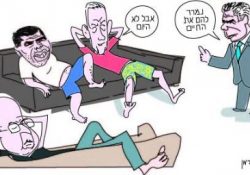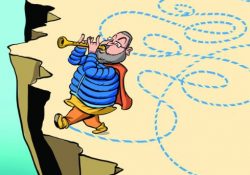Analysis
September 17 Israeli Elections – Everything You Need to Know
Category:
Israeli elections will take place on 17 September 2019. On this page you can find BICOM’s regular poll of polls, campaign updates and analysis of the parties and politicians.
On May 29, the Israeli Knesset voted to dissolve itself triggering a new election after Prime Minister Benjamin Netanyahu failed to form a governing coalition. Elections will take place on September 17, less than six months after the April 9 elections. What happened? Read BICOM’s analysis
Read our recent election bulletins:
- September 20
- September 13
- August 28
- August 2
- July 18
- July 4
- May 30
- Sign up here to receive the election bulletin straight to your inbox.
Where do the parties stand on major political issues? Read our useful roundup of the parties, politicians and key policy platforms
Final Election Results
Green – Arab | Red – left-wing | Orange – centrist | Blue – right-wing | Black – ultra-Orthodox
How the parties and their leaders shaped up
Getting to 61 without Yisrael Beitenu
Getting to 61 with Yisrael Beitenu
Netanyahu fails to win 61 seat majority
With nearly 100 per cent of the votes counted in the Israeli general election, Benny Gantz’s Blue and White party beat Benjamin Netanyahu’s Likud by oneseats (33-32), Avigdor Liberman’s Yisrael Beitenu party won 8 seats, compared to 5 in April, retaining its position as the kingmaker of any future coalition. Overall the centre-left/Arab bloc of parties outperformed the right-wing/ultra-Orthodox bloc by two seats – 57 to 55 with Lieberman’s party currently on the fence. 69.4 per cent of eligible voters turned out to vote, an increase of 1.5 per cent compared to April’s election.
The key results of the election were the surge in support for Lieberman which was likely fuelled by moderate right-wing voters, perhaps previous Kulanu voters, who decided not to support Likud. The increased support for Arab parties was also crucial and voter turnout in Arab communities was much higher, at 60 per cent compared to 49 per cent in April. It’s possible the higher voter turnout was a reaction to Netanyahu’s proposal to put cameras in polling stations in Arab communities and his repeated allegations of Arab voter fraud.
Netanyahu’s called for immediate national unity talks with Gantz were rebuffed by the Blue and White leader, who declared victory and said his party would “not be dictated to.” Gantz re-stated his intention to form a broad and liberal unity government. Netanyahu, for his part, said he was “disappointed” at Gantz’s refusal to meet.
President Reuven Rivlin will ask the party leader with the best chance of building a 61-seat majority to form a government. That candidate will have 28 days (plus the option of a two week extension) to form a coalition. If that candidate fails, the President is expected to demand they return that mandate to him so he can ask another party leader in order to avoid a repeat of what happened in April when Netanyahu initiated a vote to dissolve the Knesset.
With no easy path for Gantz or Netanyahu to form a government, the President may have to get more actively involved in the process in order to avoid a third election. Israeli political leaders will now engage in complex negotiations in which a series of creative solutions will start to appear in the media as well as stories about potential coalitions, rotating Prime Ministers, party splits and policy compromises. Some will be the result of real talks and others designed as part of the negotiation tactics to force a deal.
But analysts are predicting that the proceedings could last months. In one extreme scenario, unprecedented in Israeli history, three different party leaders could be tasked with forming a government and fail to do so – the last of whom would be at the end of December – after which the Knesset would automatically dissolve and elections called again.
Here are a few scenarios that could emerge:
- Blue and White form a grand coalition with Yisrael Beitenu and Likud – Gantz agrees a rotating Prime Minister deal with Netanyahu and Lieberman becomes Deputy Prime Minister.
- Likud and Yisrael Beitenu do a deal and form a right-wing ultra-Orthodox coalition in which Lieberman becomes Prime Minister after two years.
- Likud decide to replace Netanyahu. Their new leader forms a grand coalition with Blue and White (with or without Yisrael Beitenu). They agree a rotating Prime Minister deal.
Netanyahu is scheduled to have a pre-indictment hearing in early October to challenge the evidence in the three cases where the Attorney General has recommended he be indicted for bribery, fraud and breach of trust. Netanyahu needed a 61 seat majority to vote to grant him immunity, that’s not going to happen now so Netanyahu will attempt to stay on as Prime Minister and will refuse any offer to serve as a minister in a new coalition because minister’s are required if they are indicted for criminal offences, something likely to happen to Netanyahu in less than three month’s time.
The most likely outcome with these results is some form of grand coalition but the exact make up of that and the policy compromises required will be negotiated fiercely in the weeks ahead. But one thing is clear, Benjamin Netanyahu has failed for the second time to form a 61-seat majority coalition and that could cause intense debate in the Likud about whether they should stick with him or move to appoint a new leader.
All of our podcasts on the Israeli elections can be found here
Selected campaign videos
In this music video for the Sephardic ultra-Orthodox Shas party, various Israelis of all ages and sexes are shown in the predawn hours getting ready for their day, set against a catchy song incorporating both traditional religious lyrics and a modern “Mizrachi/Middle Eastern” melody. The Israelis all eventually arrive at synagogue for morning prayers. The video concludes with Shas’ late spiritual leader, Rabbi Ovadiya Yosef, imploring people to “take the Shas slip and put it in the ballot box.”
In this Likud campaign video, two lost hikers come across Prime Minister Netanyahu on the trail. “I’ve come to make sure you’re on the right path,” Netanyahu tells them. “My path is a lot more secure and stable, it’s challenging, but only on it do you reach the summit.” Just as the two hikers ask what lies in the other direction, to the left, a horde of screaming hikers run towards them. “Don’t go that way,” one tells them. “No one there knows where we’re going.”
The top half of this Blue and White campaign video shows Netanyahu in southern Israel in 2009 vowing “to topple the terror regime of Hamas” in the Gaza Strip if he were elected Prime Minister. The lower half of the video shows Netanyahu in September 2019 being hustled off stage by his security detail at a campaign rally in Ashdod after rockets were fired from Gaza at the southern Israeli city.
Even on holiday Israelis can’t escape the election: Blue and White bought a massive billboard on the road to Larnaca airport, Cyprus, with the image of party leader Benny Gantz and the tagline “Israel Before All” in Hebrew.
This Likud campaign video asks: “Who would you rather answer this phone call?” with the image and name of US President Donald Trump calling. The ad then goes on to pose the choice of “This man?” with an image of Blue and White number two Yair Lapid, or “Or Netanyahu?” followed by video of the Prime Minister meeting with Russian President Vladimir Putin and Trump. “We have to stop Lapid from becoming prime minister,” it says at the end, highlighting the Likud’s constant attacks on what it perceives as the weak link in the Blue and White leadership.
“Democrats, We Need to Talk,” Democratic Union official Stav Shaffir addresses the camera alone, in English, after the crisis surrounding Israel’s ban of US congresswomen Rashida Tlaib and Ilhan Omar. Shaffir blasts the Boycott, Divestment and Sanction (BDS) movement – which Talib and Omar support – as being “against peace” and wanting “an end to Israel.” Shaffir then blasts Prime Minister Netanyahu for giving a “gift” to BDS by banning the congresswomen, and calls for all “democrats” to “build an alliance, based on democracy, equality, freedom and peace.”
One of Netanyahu’s main campaign slogans is that he is in a ‘different league’ to any other Israeli leader. In a recent campaign video, Netanyahu is shown having meetings with US President Donald Trump, Russian President Vladimir Putin and the Prime Minister of India Narendra Modi with each image featuring the same slogan: ‘Netanyahu: a different league’. The video featured shots of posters (pictured above) showing Netanyahu shaking hands with Trump, Putin and Modi, which can be seen hanging outside the Likud headquarters in Tel Aviv.
- The Blue and White party responded by photoshopping the posters, saying Netanyahu was in a ‘different league’ in ‘surrendering to terrorism’ (pictured) and in the budget deficit.
- Peace Now responded with posters of their own show Netanyahu giving money to Hamas Leader Yahya Sinwar (pictured) – the Government of Israel allows Qatar to send $15m a month to Gaza. Another poster shows Netanyahu with Jewish Power leader Itamar Ben-Gvir who has a photo of Baruch Goldstein on his wall at home. Goldstein murdered 29 Palestinians in Hebron in 1994
Netanyahu recently overtook David Ben Gurion as Israel’s longest serving Prime Minister. In this campaign video Netanyahu is cooking, and discusses Israel’s first start up in the 1950’s petitim (Israeli couscous) created from wheat because there was a shortage of rice. He concludes that since then Israel has turned into a technological superpower “from Waze to Iron Dome”
- Stav Shaffir responded to Netanyahu’s cooking video asking “Why don’t you tell us what you plan for the day after the elections?” Shaffir attacks Netanyahu for appointing ministers who support conversion therapy for homosexuals and apartheid in the West Bank, adding “I know its hard for you to admit that Ben -Gurion did many other things other than creating Israeli couscous.” When Netanyahu mentions Waze she brings up an article on her phone that the CEO supported her in the Labour party primaries. And when Netanyahu discusses Iron Dome she says “I’m pretty sure someone else was responsible for that” (Labour leader Amir Peretz)
Avigdor Lieberman and Netanyahu continue to fight over so-called Russian votes. This campaign video ‘a tale of Ali-Bibi’ from Lieberman shows Netanyahu promising public housing in 2011 and saying exactly the same thing 8 years later in 2019. The video argues that Netanyahu just keeps talking, and that a vote for Lieberman’s party on September 17 will mark the end of ‘Bibi’s tales’ .
Blue and White’s campaign video argues that rather than prioritising the State of Israel, Netanyahu prioritises himself. This ad shows a TV interview in which Netanyahu flatly denied he would propose new laws to grant him immunity from prosecution before showing news clips where Netanyahu allies say he planned to introduce such laws. It concludes “Netanyahu only cares about Netanyahu”
Yisrael Beitenu has published campaign videos attacking Netanyahu for being overly supportive of religious parties In a video from June 23, Lieberman claims that a vote for Bibi is a vote for a religious government with ultra-Orthodox while a vote for Blue and White will lead to a government with both ultra-Orthodox and Arab parties. A vote for Yisrael Beitenu however will lead to a national liberal unity government. Another campaign video from July 1 shows Netanyahu in side locks surrounded by far right and ultra-Orthodox politicians, with the argument that rather than representing a ‘strong right’, Netanyahu is promoting a ‘strongly religious right.
Best Cartoons
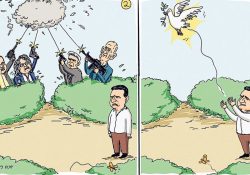
This Yediot Ahronot cartoon shows Joint (Arab) List leader Ayman Odeh release a white dove into the air (R). In the next image (L) fellow Joint List officials Ahmad Tibi and Aida Touma-Sliman, along with Blue and White leaders Benny Gantz and Yair Lapid fire and destroy the dove. In a recent Interview Odeh expressed a willingness for the Joint List to join a future government – a move rejected not only by Blue and White but also from within his own party.
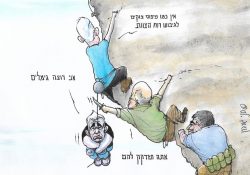
This Yisrael Hayom cartoon shows Blue and White leaders Benny Gantz, Yair Lapid, Moshe “Bogie” Yaalon and Gabi Ashkenazi. Gantz, at the top, says “Nothing like cliff climbing to mould team building,” as each one tries to drag or trip up the other. Blue and White has been roiled by mixed messaging, purported infighting, and near-weekly leaks
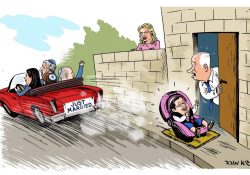
This Yediot Ahronot cartoon (30/7) shows Shaked, Bennett, Peretz and Smotrich driving off together leaving the unwanted baby Ben-Gvir (of Jewish Power) outside Netanyahu’s door.
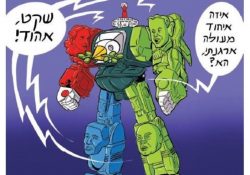
A cartoon in Maariv (28/7) shows the Democratic Union as a ‘mega Zord power ranger’, comprised as it is of so many different parts. Ehud Barak was one of the main promoters of the union, but his unpopularity among many in the Israel public and his ties to disgraced millionaire sex-offender Jeffrey Epstein led to him choosing (or being encouraged to choose) number 10 on the list. The cartoon shows Barak – who is tucked away out of sight – saying “what a great merger I put together eh?” with everyone else telling him to “be quiet”
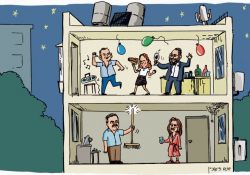
A cartoon in Yediot Ahronot (28/7) shows celebrations of the Democratic Union annoying their downstairs neighbours – Peretz and Levy-Abekasis.
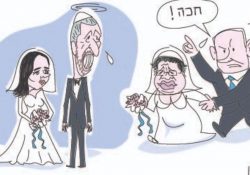
This Haaretz cartoon (26/7) shows a marriage of Shaked (New Right) and Peretz (Jewish Home) with Netanyahu trying to replace Shaked with Itamar Ben-Gvir, of Jewish Power
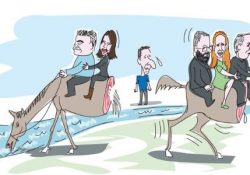
The newly formed Democratic Union also presented a stark choice to Itzik Shmuli, number 2 on the Labour list. This Haaretz cartoon (26/7) presents a horse cut in two with one side (bleeding profusely) including Peretz and Levy-Abekasis, and the other featuring the leaders of the Democratic Union.
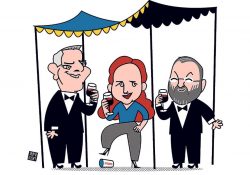
A cartoon in Yediot Ahronot (26/6) shows a three-way marriage between Meretz’s Nitzan Horowitz, Labour’s Stav Shaffir and former Prime Minister Ehud Barak, with Shaffir stamping on the glass (a tradition at a Jewish wedding) with the word ‘Labour’ on it.

This Maariv cartoon (22/7) shows Peretz inviting Levy-Abekasis onto a tree branch he is simultaneously sawing off: “Sit next to me and we will embark on a new direction” he says
Israeli media has focused on the significance of Ehud Barak’s return to politics. A Maariv cartoon (July 8) shows Ehud Barak parachuting onto a small melting ice cap on which the leaders of Blue and White, Labour and Meretz stand while telling them to ‘make space’. While Barak claims his entry into the race will increase the size of the centre-left bloc, others argue that he will further divide it, making it more likely a party wont pass the electoral threshold. Yediot Ahronot’s cartoon (July 9) ‘who will grab the wheel?’ also relates to Barak’s entry, showing him trying to hitchhike a ride from Amir Peretz, the new leader of the Labour party, but asking to drive. Barak has called for alliances between parties, but many believe his intention was to lead it himself (something Barak denies).
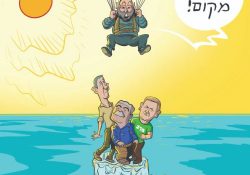

A cartoon in Haaretz (July 12 ) displays the various conversations with different leaders – Amir Peretz of Labour, Nitzan Horowitz of Meretz, Tzipi Livni formerly of Hatnua which together with Labour ran as the Zionist Union in 2015 and gained 24 seats), and Ehud Barak – over potential mergers.
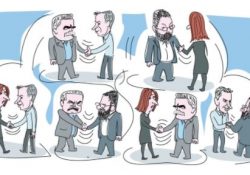
Discussions of mergers have also continued within the right wing, with Ayelet Shaked – the former Justice Minister who ran as number 2 on the New Right list in April – considered to be most popular among the wider Israeli public. A Yediot Ahronot cartoon (July 7) suggests Shaked will ‘return to her roots’ and run with Naftali Bennett and the New Right rather than with Likud or Jewish Home. And Maariv (July 9) shows leaders of the right wing parties (New Right and United Right) trying to win Shaked’s affections, as Tzipi Livni (who was rumoured to be re-forming the Zionist Union with Amir Peretz’s Labour) looks forlornly on.
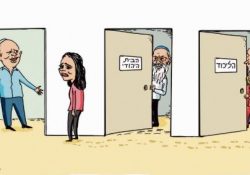
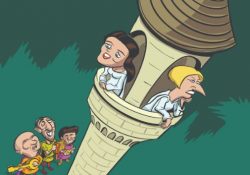
In late May, as negotiations over forming a coalition stutter on, and as the coalition parties consider voting for new elections (rather than allowing a different MK the opportunity to form a coalition) a Haaretz cartoon shows Yisrael Beitenu leader Avigdor Lieberman sitting calmly as Netanyahu leads his coalition partners off a cliff and Yediot Ahronot portrays a train wreck driven by Netanyahu.
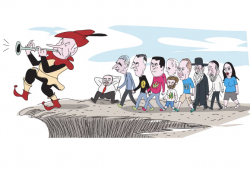
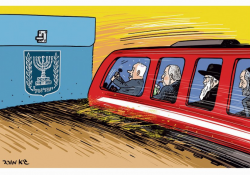
Rumours emerged that in an effort to form a coalition Netanyahu offered a number of ministies to the Labour party, Prime Ministerial rotation to Benny Gantz and a variety of incentives to the Arab parties. This Haaretz cartoon (June 27) shows Netanyahu going through different cases – each one with a different ministry on them – while calling ‘a horse, a horse, my kingdom for a horse’ as Gantz Arab leader Aymen Oden and Labou leader Avi Gabbay look on. A cartoon in Maariv (June 26) shows Netanyahu the painter in front of a colourful canvas with contradictory messages on it (elections now, cancel election, rotation etc) with the artist explaining ‘everyone sees what they want to see’.
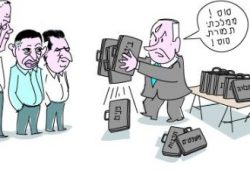
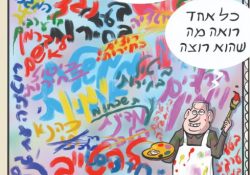
The Blue and White party have been criticised for the absence of an aggressive strategy against Netanyahu and Likud. In this Haaretz cartoon, Yair Lapid promises to ’embitter’ the lives of the government but his partners party seem unimpressed – with leader Benny Gantz responding ‘but not today’. In late June, former Prime Minister Ehud Barak announced he was returning to politics. As Barak begins forming his party, Yossi Verter in Haaretz argues that of all ex-generals vying to replace Netanyahu, only Barak has the energy, aggression and venom. Taking a different perspective, Maariv suggests that Barak is leading his supporters off a cliff, perhaps based on the argument that taking votes away from Blue and White will make Netanyahu the more likely candidate to have crack of the whip at forming a coalition.
